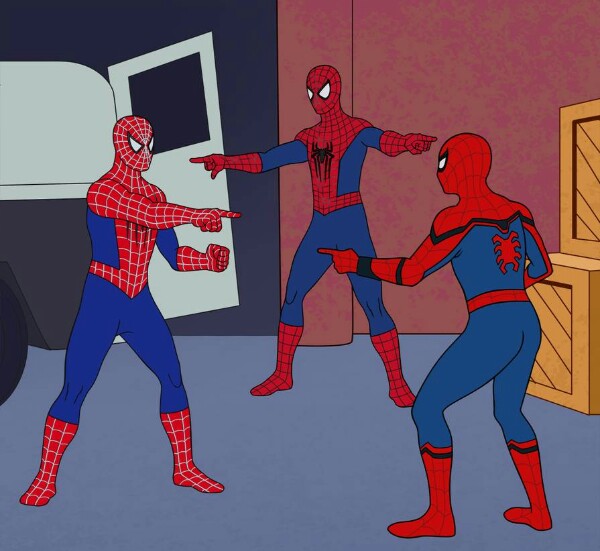What is Spider Man Triple
Create Your Own Spider Man Triple MemeSpider Man Triple
 Spider Man Triple
Spider Man Triple
The term "Spider-Man Triple" primarily refers to the highly popular internet meme known as the "Spider-Man Pointing Meme." This iconic image typically depicts three different versions of Spider-Man (or characters substituted for them) standing in a circle, all pointing accusingly or in disbelief at one another. It's a visual shorthand for situations involving mutual recognition, shared characteristics, or ironic similarities.
🤨 Meaning
The "Spider-Man Triple" meme's core meaning revolves around identifying a shared trait, action, or predicament among multiple parties. It's often used humorously to express mutual confusion, disbelief, or blame when individuals or groups realize they are in the exact same situation, have made the same mistake, or are exhibiting the same behavior. It can also signify ironic parallels, a lack of originality, or a moment of self-realization where one sees their own flaws reflected in another.
📖 Origin
The original image that spawned the "Spider-Man Pointing Meme" comes from the 1967 animated television series, specifically the episode titled "Double Identity." In this episode, Spider-Man encounters an impostor attempting to frame him, leading to the memorable scene where both Spider-Men point at each other in confusion and accusation. You can see the original scene here: https://www.youtube.com/watch?v=tM_X8_MhV8Y. The meme gained significant renewed traction and cultural relevance with the release of Spider-Man: Into the Spider-Verse (2018), which featured multiple Spider-People, and even more so with Spider-Man: No Way Home (2021). The latter film famously recreated the meme in live-action, featuring Tobey Maguire, Andrew Garfield, and Tom Holland's versions of Spider-Man pointing at each other, solidifying its place in pop culture. A clip of this recreation can be found here: https://www.youtube.com/watch?v=aG-Q1-s_m3k.
🎙️ Usage
The "Spider-Man Triple" meme is highly versatile and suitable for a wide range of humorous and observational scenarios. It thrives in contexts where irony, shared experiences, or mutual recognition are central themes.
Suitable Scenarios:
- Highlighting uncanny similarities between people, ideas, or products.
- Expressing mutual blame or shared responsibility for a situation.
- Acknowledging a common, often embarrassing or ironic, predicament.
- When multiple entities are performing the exact same action or exhibiting the same trait.
- In discussions about identity, imposters, or parallel realities (playing on the Spider-Man multiverse theme).
Examples of Use:
- Online Debates: When multiple users in a comment section make the exact same witty remark or observation, leading to a humorous 'pointing' situation.
- Product Design: Illustrating how different companies release strikingly similar products, leading to market confusion or a lack of innovation.
- Personal Anecdotes: A group of friends all showing up to an event wearing identical outfits, creating an awkward yet funny moment of recognition.
- Workplace Humor: When different departments or team members blame each other for an issue, only to discover they all contributed to the problem in similar ways.
- Pop Culture Commentary: Pointing out how different movies or TV shows borrow heavily from similar tropes or plotlines, creating a sense of 'been there, done that'.





